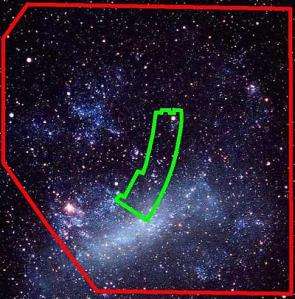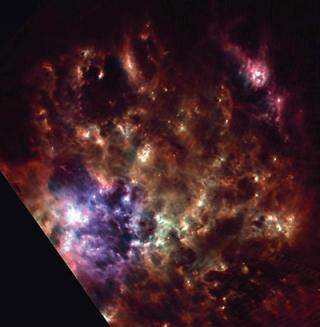Revealing the mysteries of galaxy formation

As the AKARI satellite nears completion of its All Sky Survey, it has released two stunning images of the Large Magellanic Cloud. AKARI is an infrared astronomical satellite from the Japan Aerospace Exploration Agency (JAXA) with involvement from the UK, the Netherlands and the European Space Agency.
Dr Stephen Serjeant of the Open University, commenting on the new images said, "AKARI has given us a superb view of the Large Magellanic Cloud - a dwarf galaxy which our own galaxy is consuming. All galaxies cannibalize each other; in time, our own galaxy will be subsumed within the Andromeda galaxy."
The Large Magellanic Cloud is a dwarf galaxy orbiting our own galaxy. It lies at a distance of about 160,000 light years, having about 1/20 the diameter of our galaxy and 1/10 the number of stars. It is believed that the LMC was once a barred spiral galaxy that was disrupted by the Milky Way to become somewhat irregular.
The Large Magellanic Cloud contains about 10 billion stars and is at a distance of 160,000 light years, extremely close by astronomical standards. The Large Magellanic Cloud is located in the constellation Dorados in the southern sky. The name "Magellanic" is taken from the great 16th century navigator Magellan who observed the clouds during his voyage around the world.

AKARI (formerly known as ASTRO-F) was launched in February 2006 and began its All Sky Survey in May. It is the first new infrared survey satellite since the 1980s and the data it collects will shed new light on the dusty Universe – such as areas where stars are born and die.
Dr Chris Pearson, European Space Agency support astronomer for AKARI, said, "The spectacular images of the Large Magellanic Cloud in the Far-Infrared give us a first mouth watering taste of what we can expect from the AKARI All-Sky Survey as the satellite continues to sweep out great swathes of the sky."
Dr Seb Oliver of the University of Sussex added "AKARI has now mapped virtually the whole sky. This is a tremendous achievement by all concerned. These examples show the impressive quality that we can expect from the first far infrared sky survey for 20 years."
During the survey observations, AKARI investigated one of the most important targets for studies of the formation of galaxies, the Large Magellanic Cloud, over more wavelength bands than has ever been possible in the past. Using the data taken by AKARI astronomers will be able to unlock the secrets of how both the Large Magellanic Cloud and our own Galaxy have formed and have grown to their current state.
Professor Glenn White of the Open University / CCLRC Rutherford Appleton Laboratory said "this stunning AKARI image traces the far -infrared emission from a noticeable bar of stars, some of which, including S Doradus, are extremely luminous. The Large Magellanic Cloud is rich in a variety of diffuse nebulae, including the spectacular Tarantula Nebula, planetary nebulae, open clusters, globular clusters, which suggest that it has experienced early and late bursts of star formation."
Since most stars are formed deep in dusty clouds of interstellar gas, their starlight is not directly visible in the optical, but light from the young stars heats the surrounding dust, which in turn radiates at infrared wavelengths that can escape the dusty clouds. However, if dust is very widespread and thick throughout galaxies, the stars which heat the surrounding dust may not be just the young stars, so the observed infrared radiation would not be the good measure of star formation rates that it is usually assumed to be. Clarifying the dust content of typical galaxies is important to understanding how they evolve over time, as interstellar gas is transformed into stars. These AKARI far infrared surveyor observations are designed to trace the distribution of warm dust close to hot stars, and the associated star-formation rate. Understanding this in one of the Local Group galaxies in our own backyard is crucial to our understanding of the formation and evolution of more distant galaxies.
Dr Rich Savage of the University of Sussex said, "These latest images are a great example of the new views of the cosmos that AKARI is giving us."
Dr Elysandra Figueredo of the Open University said, "I'm really very impressed with these images but much more impressed about the superb scientific insights this data bring. It's very exciting to see the structure and the content of the compact star-forming regions distributed throughout our neighbour galaxy. These regions are crowded with newly born stars that are probably still inside their cocoons. This is a new view Large Magellanic Cloud and it will certainly help us a great deal in understanding the birth of stars like our Sun, and also bring new insights about our own Galaxy."
Dr David Clements from Imperial College London said, 'The last all sky far infrared survey, made by the IRAS satellite, was completed in 1983 but astronomers still refer to it on a daily basis. These early results from AKARI show just how much of an advance the new survey is going to be - we'll be using AKARI data daily for at least the next 20 years!'





















